

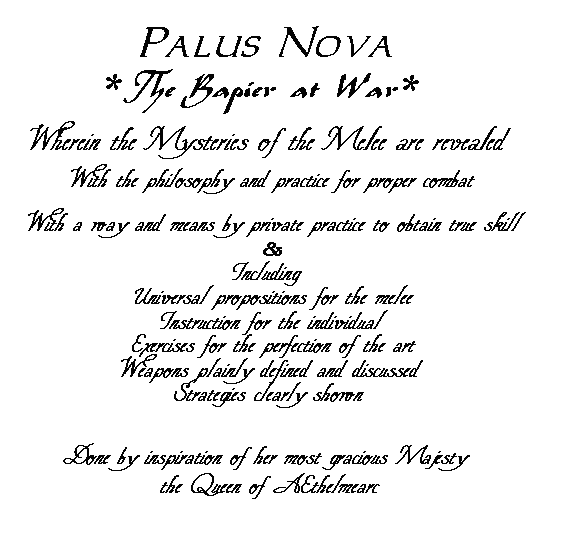
Part I
Instruction for the individual fighter
The fundamental concept of melee is to act in concert as a single body:
 Melee is not something to be taken lightly. It is different from single combat in variety of ways. The most important, is the safety factors inherent in any melee situation. If youíre a nice safe fencer in single combat, that doesnít necessarily mean you can just jump into a big melee and maintain the same level. If you have never meleed before, you may want to consider watching one first. Take the chance to see the confusion and energy before youíre standing knee deep in it. Melee in small groups first, 2 on 2, 3on 3 etc. Get a feel for what melee is before you jump into a big battle at war.
Melee is not something to be taken lightly. It is different from single combat in variety of ways. The most important, is the safety factors inherent in any melee situation. If youíre a nice safe fencer in single combat, that doesnít necessarily mean you can just jump into a big melee and maintain the same level. If you have never meleed before, you may want to consider watching one first. Take the chance to see the confusion and energy before youíre standing knee deep in it. Melee in small groups first, 2 on 2, 3on 3 etc. Get a feel for what melee is before you jump into a big battle at war.
In melee conditions the probability that both sides of your calibration will go up is very high. Recognizing shots and calling them properly becomes much tougher. In melee you get bumped and shoved and quillioned by your partners etc. All of this has to be separated from real shots and where they land. The other side of calibration gets harder as well. With the increased excitement and adrenalin levels you will tend to start throwing shots harder. It is a natural reaction to the conditions of melee. Thatís why being aware of your actions are so important. Take your calibration awareness in single combat and triple it. Another safety consideration unique to melee is your footing. You cannot move about in melee as you would in single combat. Tripping or slamming into someone is a real possibility. Often melee scenarios have obstacles or structures set up that need to be watched for as well.
A melee is not a bunch of single combats going on simultaneously. Thinking in this manner will get you and your partners taken out fast. In the context of a melee the individual disappears and becomes a part of the larger whole. What does this mean in real terms? Leave your ego and thirst for personal glory at home. As part of a line your movements and actions no longer affect just you. The simple strategic movements that you readily use while in single combat now can have a disastrous effect on your partners. Conversely your actions can become a great assistance to your partner helping him take out the enemy and survive the fight. The simple act of stepping back, a movement common and sensible in single combat, can now place your partners in a bad spot. This means that your focus must expand beyond the opponent directly in front of you. The same concentration that you place on your opponent must now be spread to everyone in your reach and the larger fight going on around you.
Your range of defensive and offensive actions include your partners on your immediate left and right. You must become offensively and defensively aware of everyone within your reach. Typically this means at least three of your opponents. The one directly in front of you, and the opponents directly to that persons left and right. It is these three people that will make you dead. While this may seem a bit much for one person, take heart, your partners are doing the same. This creates an overlap of coverage that is the strength of a good melee unit. If done properly each and everyone on the opposing line has at least three people to worry about.
The more familiar you are with your melee partner the better. The only way to gain this familiarity is to practice. You donít have to have a large group of fighters to practice melee. Ideally I preferred to have two teams of three, but that is by no means necessary. Many of the elements on melee can be practiced with just three fencers (two on one). All the necessary aspects of melee combat can be practiced as a group of two opposing two. If you can get just 3 or 4 people in the same place you have it made.

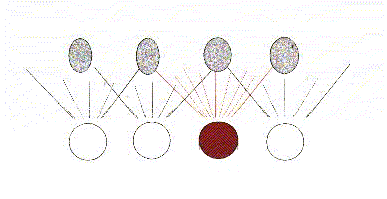

What to take to the fight:
Weapons choice for melee
AEthelmearc recognizes five weapons forms for rapier combat. All five are allowed in melee combat. Some consideration should be given to which weapons form you and your unit choose. If you feel proficient in a specific form while fighting single combat, that does not necessarily mean it will be a good melee choice. How your melee unit is organized has everything to do with the roles each of its members take (see melee unit development Bog class) Some weapons forms lend themselves better to certain tasks than others. Each form has it strengths and weaknesses.
1. Single rapier
A good choice, simple and easily controlled in a crowd. Single rapier has no off hand capabilities beyond the empty hand.
2. Rapier and dagger
Also a good choice. The different length blades makes them easily controlled and helps prevent entanglement, although the inside movements required to use a dagger offensively are difficult and dangerous thereby severely limiting the daggerís usual strength. The dagger is going to be 95% defense. Unless you parry well with the dagger you may want to use another form
3. Rapier and rigid parry.
Excellent choice. Simple to control. Great defensesive capabilities. It does however prevent any off hand attacks
4. Rapier and non-rigid parry.
Probably the least useful melee form. The very nature of non-rigid makes it very susceptible to entanglement with your and your partners blades. However if youíre good with non-rigid it can work.
5. Case of rapier.
A form that would at first glance seem the ideal choice for melee. All the problems of case, using both blades effectively and keep them free and in line, are multiplied by 100 when in melee. But if you are capable of conquering all the problems of case, it is a great melee form.
When you consider what weapons form to use do not think of it merely as what would work well for you. Consider form combinations, what you and the persons on either side of you are using. Imagine if you will. Three fighters. Two with buckler and rapier with someone using case in the middle. Deadly combination.

Communication: Silence is golden, but not in melee.
Awareness is a very important element to effective melee tactics. The commander must know what the entire line is doing. And the individual must know what the fighter to his left and right are doing. For the individual physical contact is the basic means of communication (see close order line) Rudimentary elbow contact will let your partner know you are there. If the line is forced to spread an occasional touch to your partners shoulder will tell them they arenít alone. Donít make your partner look around to see if you are there. The majority of kills in a melee are achieved when someone turns their head to see what is going on!
It is often the case that your partner to your left or right gets taken out and you are not aware of it. Thatís not your fault, you were busy fighting. They should have told you. If you get taken out, in a loud voice YELL DEAD. I said yell DEAD, not Good, Yes, or even damn! Let those nearest you know the situation has changed. Raise your rapier over your head (as per melee conventions) so the commander knows the situation has changed as well. If you suddenly find yourself the end of the line and a vast horde of the opposing army starts to pour around you, YELL as desperately and loudly as you can FLANK!! This will let everyone know things just got ugly. If a harrier comes sweeping around and behind the line let the world know about it. The more informed we can keep each other the better. Now of course this doesnít mean you sing out every time you notice something. Yelling, "Don Duodenum is tying his shoe" isnít really useful. Be vocal. If you see something or are going to do something that will impact the fighter next to you, tell them about it. If something happens and only you know about it, no one can help you. Melee is about acting together. Remember this does not mean you are telling anybody to do anything. Youíre merely keeping everyone informed (see command structure)
Always remember and never forget there is no substitute for practice
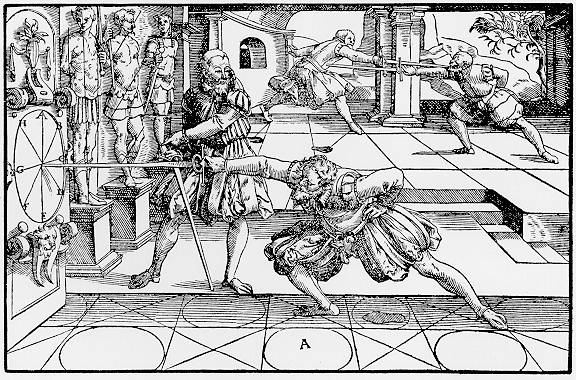
Command structure: Who is in charge
Effective melee relies heavily on organization. There are a myriad of ways to organize a melee unit. Whatever the organization is make sure everyone knows it. There will be commanders. It is the commanderís job to wield the melee unit like a sword and attack the enemy. This can be accomplished many ways. Typically sub officers are employed. But beware use only as many bosses as you absolutely need. Otherwise matters become confused not organized. We in the SCA have a tendency to try to make everybody something. While this is always done in the spirit of comradery its not terribly efficient. No one person is more important than any other. Whether you are an officer or not, the unit relies on you. As part of the unit you are something, irreplaceable! Consider how many people you need shouting orders. Then try working the line. Then see if you can do it with fewer, then fewer. Pare it down to the absolute essential number. The following is without doubt the most difficult part of being in a melee unit. If you are not the officer in command or one of their sub officers, Keep your Mouth shout and do what you are told!!! (Unless of course you are keeping others apprised of the situation. see communication) This seems a bit harsh, but there is no other way to say it. As a line soldier " yours is not to reason why, yours is but to do and die" There will be times that you or your portion of the line will have to take one for the unit. Yes, sacrificed! Its part of unit play. In the end it will help your unit win. If it doesnít and your officer repeatedly sacrifices you.... mutiny is always an option.

The principal formation used to maintain this unit cohesion is the line. The line formation is what allows us to work together. The line formation is most easily manipulated to achieve specific goals or meet specific threats. How to maintain and work within the line formation is a principal concern of a melee unit.
Keeping the line: The line must be maintained from the line of the shoulder not the tip of the sword. This is very important so I will say it again. The line must be maintained from the line of the shoulder not the tip of the sword. Bodies must remain in line. Nothing should draw you out of the line. Attacks should be arm thrusts only. A single step or extended lunge will take you out of line and therefore bring you within range of two and possibly even three swords of the opposing line while at the same time taking you out of effective assistance range from your own partners. Stepping back or simply voiding an income shot can leave your partners open and vulnerable as well.
Maintaining the line from the shoulder may appear to take those of shorter reach out of effective range. While it may be true that those of shorter reach may not be able to score a touchť on the opposing line this does not mean they cannot be effective. Effective melee work relies on working as a unit. If you are in fact out of range of the opposing line you can still bind swords, parry incoming shots and generally assist those that are within range. It is very difficult to maintain the line. The urge to lunge out is almost irresistible. It is really hard to stop that reflex of stepping back as well but it is an absolute must if a line is to be effective. There will be a time to break the line and engage the enemy save your lunges for that moment. If you arenít alive you canít help!
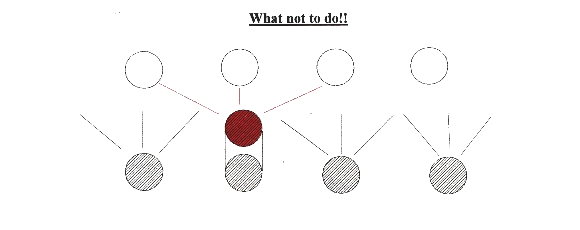
Something to try: Against the wall drill
Place the foot of your off side against the wall. And leave it there. Fight from this position; maintain contact with the wall at all times. This will help you resist the urge to lunge out and teach you to trust your parries for defense.
Stay alive: Now that youíre in the line solidly, your focus includes everyone in your range, you are part of the unit in mind and body. What does that unit do? First and foremost that unit stays alive! This doesnít not mean that you never attack. You do, but when the opportunity arises or is created. Staying alive is the default setting for the melee unit. If youíre not commanded to do other wise you stay alive and take those targets of opportunity when you can. Donít make a mistake and get them to make one. Stay in your line and get them to step out of theirs (how exactly to do this will be covered later). When your commander sees the opportunity to go for it they will tell you. Until then donít make a mistake and be the meat grinder.

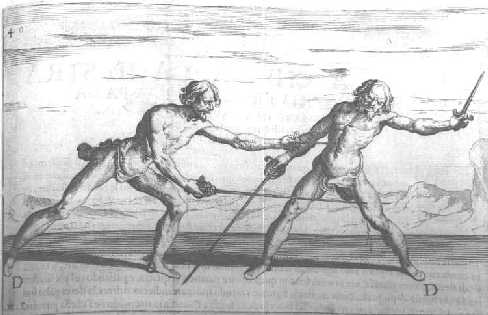
the dangers of stepping out of line
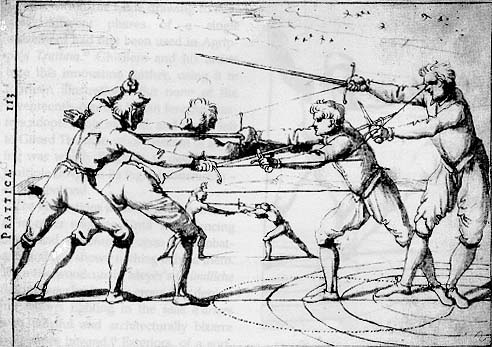
As the line will be your basic formation it is essential to understand where you are in the line and how to move it and maintain your organization. Two effective orders (spacings) of line can be used and easily practiced by just a few fighters. They are as follows.
Close order and open order:
Close order line: Fighters are close enough to maintain rudimentary elbow contact with one another. This allows the individual to be aware of the movements of the fighter on either side as they move left right forward and back without looking at them. How many times have you been taken out as you turned your head to see what happened to the person next to you? Donít do it. Feel for them with your elbows. This is the closest effective spacing. If the line were more compact the individual fighter would not be able to move effectively.

Open order line: The fighter extends their right arm parallel with the line. Each fighter shifts right till the tip of the sword of the fighter on the left reaches to the point of their right shoulder. This is the most extreme effective spacing for a line. With this spacing each individual fighter remains within range of one another to still give assistance while presenting a broader front. To open the order (spacing) of the line any greater would isolate fighters and reduce to situation to individual combat.


As the melee gets underway it frequently becomes necessary to let one another know what is going on. For this to be useful we have to all use the same words to mean the same thing. Here are the basic areas that you will most often have to refer to.
Where are you:
Any line can be thought of as being comprised of three basic parts. The center, the left flank, and the right flank. There will be times in melee combat one portion of line will execute a maneuver by itself. Therefore it becomes necessary to know where you are in the line. The three basic parts are self-explanatory. Left and right is figured from your prospective as you stand in the line. In other words the right of the line is to your right and so on. The flank is the extreme end of the line in either direction. The extreme end of the line to your right is then the right flank and the extreme left, the left flank. And then the center is, well the center.

Where are we:
The line that you are in exists in a space on the field. Other parts of the field are described in relationship to the line. The four main parts of the field are the Front, the rear. The left and right flank. Think of them as the four points of the melee compass.
Where are they:
With these simple words we can all easily explain what the other side is doing if we have to. And there will be times when you have to. i.e. Enemy on our right flank or attack in our center...etc.

What do you do with the line: Once the line is formed it can be manipulated and moved about the field with a few simple maneuvers.

Forward/Advance Fall back/ Retreat
The simplest line movement is forward and backward. For melee purposes there are two commands for moving forward and two for backward. The commands to move the line forward are Forward and Advance. Two orders; two forward movements. Upon the command Forward, the entire line moves forward slowly and carefully in good order until the order halt is given. This is used to cover large areas that arenít occupied by the opposing force. Upon the order Advance, the line moves forward one step. This order is used to have the entire line move forward and attack a line immediately in front of them. Since the line moves forward only one step no halt is necessary. Two orders for moving backwards as well. Two orders, two movements. Upon the order to fallback, the entire line moves backward in good order facing forward as they move. The line continues to move backwards until halt is given. This is used the get the line out of a bad situation. Covering large areas of ground. The second movement backwards is retreat. Upon Retreat the line moves back on step while facing forward. Again no halt is necessary. Used when engaged with the enemy. Remember a single step. In other words, there are commands for when you are engaged and for when you are not. The orders for when you are engaged are fencing moves.
Wheel and Turn
Any time a line turns it can be done two ways. The wheel or the turn. In both cases maintaining the line is no easy, but a few simple tips will help. Both are done as circular movements. Keep in mind the person on the outside of the circle must move faster than those on the inside. The pivot point must remain in position and only turn.


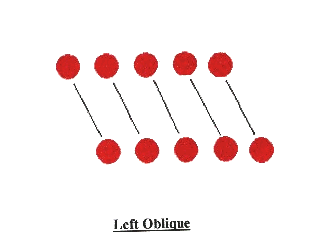
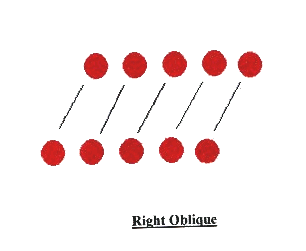
Review

1. Learn to act as a unit not a single fighter
2. Arm yourself well, considering the whole unit
3.Let your unit know whatís going on, communicate
4. Chose your commander well, keep it to a bare minimum, be a good soldier
5. Learn to form a line and stay in it.
6. Learn to move forward, back, left and right while maintaining the line


In Service of the Crown and Populace






 Melee is not something to be taken lightly. It is different from single combat in variety of ways. The most important, is the safety factors inherent in any melee situation. If youíre a nice safe fencer in single combat, that doesnít necessarily mean you can just jump into a big melee and maintain the same level. If you have never meleed before, you may want to consider watching one first. Take the chance to see the confusion and energy before youíre standing knee deep in it. Melee in small groups first, 2 on 2, 3on 3 etc. Get a feel for what melee is before you jump into a big battle at war.
Melee is not something to be taken lightly. It is different from single combat in variety of ways. The most important, is the safety factors inherent in any melee situation. If youíre a nice safe fencer in single combat, that doesnít necessarily mean you can just jump into a big melee and maintain the same level. If you have never meleed before, you may want to consider watching one first. Take the chance to see the confusion and energy before youíre standing knee deep in it. Melee in small groups first, 2 on 2, 3on 3 etc. Get a feel for what melee is before you jump into a big battle at war. 





















